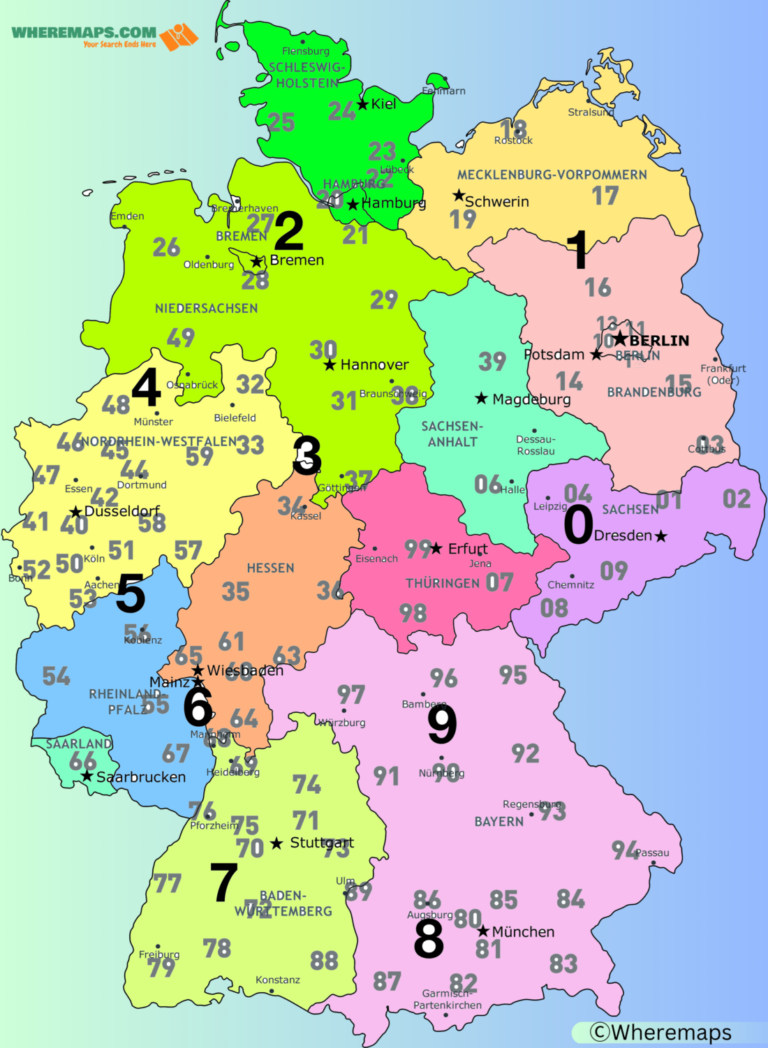What is a German Postal Code?
German postal codes—often abbreviated as “zip codes”—are a system of numbers used by the German postal service to differentiate between various national regions. The codes consist of five numbers, the last three identifying a specific postal area inside the first two identifying the region.
Information of Germany |
|
|---|---|
| Country | Germany |
| Capital | Berlin |
| Population | 83.1 million |
| Official language | German |
| Currency | Euro (EUR) |
| Population Density | 2,287 / km² |
| Postal Codes | 28278 as of June 2018[1] |
| Area Codes | 5,225+ |
| Federal States | 16 |
| Cities | 2,055 |
Postal codes of major cities in Germany
| Area | Postal Code |
|---|---|
| Berlin | 10115-14199 |
| Hamburg | 20095-21149 |
| Frankfurt | 60306-60599 |
| Munich | 80331-81929 |
| Cologne | 50667-51149 |
| Stuttgart | 70173-70619 |
| Leipzig | 04103-04357 |
| Dresden | 01067-01277 |
| Nuremberg | 90402-90491 |
| Hanover | 30159-30669 |
Postal Codes in Germany region-wise
| Region | Postal code range |
|---|---|
| Berlin | 10115–14199 |
| Brandenburg | 03001–15938 |
| Baden-Württemberg | 68159–79948 |
| Bavaria | 80331–97737 |
| Bremen | 28195–28779 |
| Hamburg | 20095–21149 |
| Hesse | 34117–64689 |
| Lower Saxony | 21335–29996 |
| Mecklenburg-Vorpommern | 17001–23999 |
| North Rhine-Westphalia | 32049–59969 |
| Rhineland-Palatinate | 54290–67759 |
| Saarland | 66111–66687 |
| Saxony | 01001–09999 |
| Saxony-Anhalt | 03901–39999 |
| Schleswig-Holstein | 21001–25999 |
| Thuringia | 04001–99998 |
Note:- Click here to see the full list.
How can you read a postal code in German?
German zip codes are straightforward to understand. The first two digits identify the region, while the final three digits identify the specific postal area that lies inside that region. For instance, Berlin’s Mitte neighborhood is identified by the zip code 10117.
How to Use a German Postal Code?
Using a German postal code is straightforward. When addressing mail or parcels, the postal code should be written on the last line of the address, following the city/town and street name. For example:
Hans Schmidt Marienplatz 10 80331 München Germany
In this example, 80331 is the postal code for Munich, Germany.
Understanding German Postal Regions
As mentioned earlier, the first two digits of the German postal code represent a larger geographical region. There are currently nine postal regions in Germany, each of which is represented by a unique range of two-digit codes. These regions are:
- 0: Northern Germany
- 1: Eastern Germany
- 2: North-Western Germany
- 3: Central and Eastern Germany
- 4: South-Western Germany
- 5: Central and Southern Germany
- 6: Western Germany
- 7: South-Western Germany
- 8: Southern Germany
- 9: South-Eastern Germany
Decoding German Postal Codes
Decoding a German postal code can help you understand the location it represents. The first two digits of the code can tell you which postal region the location belongs to, while the last three digits represent a smaller locality within that region.
For example, a postal code that starts with “10” belongs to the postal region of Eastern Germany. The next three digits, such as “123“, identify a specific locality within that region. Therefore, the full postal code “10123” could correspond to a location in Berlin, Germany.
Common German Postal Codes
Some German postal codes are more commonly used than others. Here are a few examples of well-known German postal codes:
- 10115: Berlin Mitte
- 60311: Frankfurt am Main
- 80331: Munich
- 20095: Hamburg
- 40213: Düsseldorf

